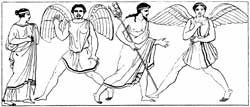Gorgon

Homer knows only one Gorgo, who, according to the Odyssey,1 was one of the frightful phantoms in Hades: in the Iliad,2 the aegis of Athena contains the head of Gorgo, the terror of her enemies. Euripides3 still speaks of only one Gorgo, although Hesiod4 had mentioned three Gorgones, the daughters of Phorcys and Ceto, whence they are sometimes called Phorcydes or Phorcides.5
The names of the three Gorgones are Stheno (Stheino or Stenusa), Euryale, and Medusa,6 and they are conceived by Hesiod to live in the Western Ocean, in the neighborhood of Night and the Hesperides. But later traditions place them in Libya.7 They are described8 as girded with serpents, raising their heads, vibrating their tongues, and gnashing their teeth; Aeschylus9 adds that they had wings and brazen claws, and enormous teeth. On the chest of Cypselus they were likewise represented with wings.10
The mythus respecting the family of Phorcys, to which also the Graeae, Hesperides, Scylla, and other fabulous beings belonged, has been interpreted in various ways by the ancients themselves. Some believed that the Gorgones were formidable animals with long hair, whose aspect was so frightful, that men were paralyzed or killed by it, and some of the soldiers of Marius were believed to have thus met with their death.13 Pliny14 thought that they were a race of savage, swift, and hair-covered women; and Diodorus15 regards them as a race of women inhabiting the western parts of Libya, who had been extirpated by Heracles in traversing Libya.
❧
Iconography
References
Notes
- xii, 633.
- v, 741, viii, 349, xii, 36; comp. Virgil. Aeneid vi, 289.
- Ion, 989.
- Theogony, 278.
- Aeschylus. Prometheus Bound, 793, 797; Pindar. Pythian Odes xii, 24; Ovid. Metamorphoses v, 230.
- Hesiod, l.c.; Pseudo-Apollodorus. The Library ii, 4.2.
- Herodotus. Histories ii, 91; Pausanias. Description of Greece ii, 21.6.
- Shield of Heracles, 233.
- Prometheus Bound, 794. ff.; Libation Bearers, 1050.
- Pausanias. Description of Greece v, 18.1.
- Athenaeus, v, 64.
- Naturalis Historia iv, 31.
- iii, 55.
Source
- Smith, William. (1870). Dictionary of Greek and Roman Biography and Mythology. London: Taylor, Walton, and Maberly.
This article incorporates text from Dictionary of Greek and Roman Biography and Mythology (1870) by William Smith, which is in the public domain.